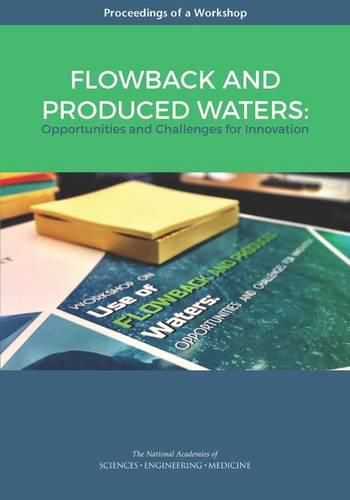Flowback and Produced Waters: Opportunities and Challenges for Innovation: Proceedings of a Workshop
National Academies of Sciences, Engineering, and Medicine,Division on Earth and Life Studies,Water Science and Technology Board,Board on Earth Sciences and Resources,Roundtable on Unconventional Hydrocarbon Development

Flowback and Produced Waters: Opportunities and Challenges for Innovation: Proceedings of a Workshop
National Academies of Sciences, Engineering, and Medicine,Division on Earth and Life Studies,Water Science and Technology Board,Board on Earth Sciences and Resources,Roundtable on Unconventional Hydrocarbon Development
Produced water?water from underground formations that is brought to the surface during oil and gas production?is the greatest volume byproduct associated with oil and gas production. It is managed by some combination of underground injection, treatment and subsequent use, treatment and discharge, or evaporation, subject to compliance with state and federal regulations. Management of these waters is challenging not only for industry and regulators, but also for landowners and the public because of differences in the quality and quantity of produced water, varying infrastructure needs, costs, and environmental considerations associated with produced water disposal, storage, and transport.
Unconventional oil and gas development involves technologies that combine horizontal drilling with the practice of hydraulic fracturing. Hydraulic fracturing is a controlled, high-pressure injection of fluid and proppant into a well to generate fractures in the rock formation containing the oil or gas. After the hydraulic fracture procedure is completed, the injected fluid is allowed to flow back into the well, leaving the proppant in the newly created fractures. As a result, a portion of the injected water returns to the surface and this water is called flowback water which initially may mix with the naturally occurring produced water from the formation. The chemistry and volume of water returning to the surface from unconventional oil and gas operations thus changes during the lifetime of the well due to the amount of fluid used in the initial stage of well development, the amount of water naturally occurring in the geologic formation, the original water and rock chemistry, the type of hydrocarbon being produced, and the way in which production is conducted. The volume and composition of flowback and produced waters vary with geography, time, and site-specific factors.
A workshop was conducted by the National Academies of Sciences, Engineering, and Medicine to highlight the challenges and opportunities associated in managing produced water from unconventional hydrocarbon development, and particularly in the area of potential beneficial uses for these waters. This publication summarizes the presentations and discussions from the workshop.
This item is not currently in-stock. It can be ordered online and is expected to ship in approx 4 weeks
Our stock data is updated periodically, and availability may change throughout the day for in-demand items. Please call the relevant shop for the most current stock information. Prices are subject to change without notice.
Sign in or become a Readings Member to add this title to a wishlist.


